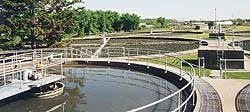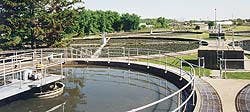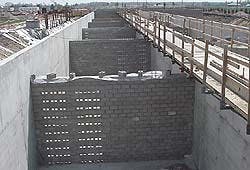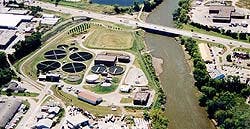Iowa City's original North Wastewater Treatment Plant was aging. Stringent ammonia restrictions implemented by the Iowa Department of Natural Resources (IDNR) necessitated that the plant be phased out.
The North Plant, a trickling filter plant, is connected to another plant, the South Plant, with a large interceptor and intermediate pump station to maintain reliability. The South Plant is a conventional activated sludge system with anaerobic digestion of waste solids.
Stanley Consultants, in conjunction with the owner, The City of Iowa City, determined that the best solution to the treatment challenge was to divert a portion of the North Plant's flow to the South Plant.
Stanley Consultants, headquartered in Muscatine, IA, was awarded the contract for the design and construction phase services for the South Plant improvements. The plant is being expanded from a 5 mgd activated sludge plant to a 10 mgd activated sludge plant with nitrification/denitrification capability; temperature phased anaerobic sludge digestion; and complete laboratory, administration, maintenance, and vehicle storage buildings.
The new systems will bring the city info compliance with more stringent ammonia regulations and allow for the phase out of the North Plant. The upgrade will provide ample capacity for both plants' solids now and into the future.
The $25.5 million project is a year and a half into construction with about six months to go.
The new system uses fine bubble membrane disk diffusers to aerate the wastewater. The diffuser type was selected to minimize fouling by solids and to provide efficient oxygen transfer. Five 300 hp centrifugal blowers supply air to the activated sludge system, which was designed to use four trains of eight cells each.
The system features baffle walls between cells to create a series of complete mix cells that in a series mimic plug flow. Mixers in the first through fourth cells and last cell allow air to the cells to be shut off during mixing to create anoxic zones. Operator flexibility is necessary to create the zones to foster nitrification and some denitrification.
The nitrification biological process removes ammonia through bacterial conversion to nitrate. The use of anoxic zones allows some denitrification, the bacterial conversion of nitrate to nitrogen gas, to occur. Bacterial denitrification uses nitrates as an energy source instead of oxygen, while consuming biochemical oxygen demanding materials.
This process saves energy (money) by reducing the oxygen needed to treat the wastewater. Denitrification also helps maintain wastewater alkalinity by releasing alkalinity as the process occurs. The activated sludge system also allows mixed liquor recycle to bring nitrates and nitrifying bacteria back to the front of the process.
An important addition to the treatment system is an equalization tank for high strength waste from the digesters and belt filter press. The tanks hold and meter the wastes, which also have high ammonia levels, back into the influent stream. If added in slug loads, they could cause upsets in the activated sludge process.
The plant expansion includes additional primary and secondary clarification capacity; improvements to the return activated sludge (RAS) pumping system; expanded wastewater equalization capacity provided by earthen lagoons; and additional chlorine contact basin capacity.
A new grit removal system was installed. It consists of vortex grit removal units with grit slurry pumping and a new dewatering facility to replace manual grit removal from aerated grit chambers. The new system will address operational and safety issues associated with the manual grit system.
The vortex grit removal system, anti-foam feed capability, and water sprays at turbulent locations will help to control periodic foaming problems at the plant associated with local industry.
A new temperature phase digester complex has been added with four anaerobic digesters to provide the potential to produce Class A biosolids. Stainless piping and digestive covers were installed to minimize ongoing maintenance associated with traditional sludge piping systems.
The new digester complex replaces three digesters at the North Plant that are to be abandoned. Currently, digested solids are pumped approximately four miles from the North Plant to the South Plant. In the future, raw solids at the North Plant will be held in an equalization tank and pumped to the South Plant digestion complex.
Additionally, a new laboratory administration office building for the city's wastewater treatment plant staff has been constructed. A vehicle maintenance facility, to house equipment, enhances the Iowa City Wastewater Division's effectiveness and efficiency, and improves equipment maintenance and reliability. The new buildings will allow the city to consolidate Wastewater Division operations at a single location. WW/






